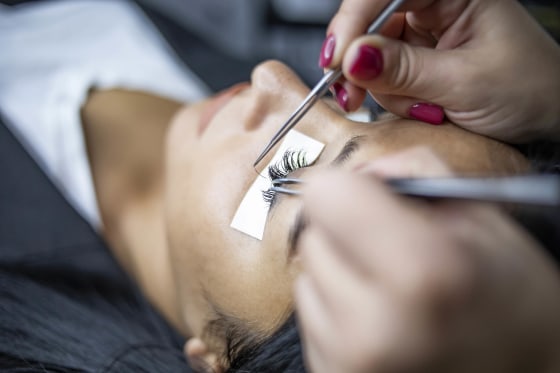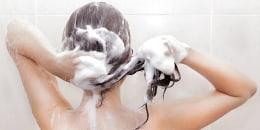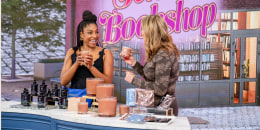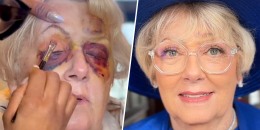Eyelash extensions have become an increasingly popular beauty trend in recent years. On TikTok, the hashtag #lashextensions has over 9.4 billion views and features countless videos of people taking their lashes to new lengths.
Unlike their predecessor false eyelashes, semi-permanent eyelash extensions promise to make your lashes look fuller, longer and darker for weeks — no daily reapplication or mascara necessary.
Yet, this trend prompts some questions: What are eyelash extensions actually? How are they applied? Are there any health risks to the eye? We spoke to experts about how eyelash extensions work, the possible risks, and how to get lash extensions safely.
How are eyelash extensions applied?
Eyelash extensions are tiny fibers resembling real eyelashes, which are glued one by one to individual natural eyelashes at the base of the hair along the lash line, Dr. Ashley Brissette, spokesperson for the American Academy of Ophthalmology and assistant professor at Weill Cornell Medicine and New York Presbyterian Hospital, tells TODAY.com.
The extensions are glued using an eyelash extension adhesive, Brissette explains, which contain various ingredients to hold the lash in place. The U.S. Food and Drug Association considers eyelash extensions and adhesives to be cosmetic products, which means they must adhere to cosmetic safety and labeling requirements.
What are the different types of eyelash extensions?
The extensions are made from a range of materials including synthetic fibers like acrylic, real mink or sable fur, and silk, experts previously told TODAY.com.
“They come in different shapes, sizes and colors,” says Brissette, adding that they may be applied to each eyelash or spaced out for a more natural look. Some people are allergic to animal fur, so for these people, synthetic lashes work best, Jennifer Garcia, lash stylist at Maud’s of Beverly Hills, previously told TODAY.com.
Who can apply eyelash extensions?
Eyelash extensions are usually applied by certified technicians or estheticians in a licensed salon, says Brissette. However, there are an increasing number of home eyelash extension services cropping up and do-it-yourself kits available on the market.
But the experts agree eyelash extensions should always be applied by a certified or licensed professional. “Make sure you’re going to a reputable place and the tools (are) cleaned properly,” says Brissette.
Home services or DIY kits are not worth the risk, the experts note.
How long do eyelash extensions last?
Since eyelash extensions are glued to the natural eyelashes, they typically last until the eyelashes fall out, which happens in cycles like the hair on your head.
"The lifecycle of eyelashes is about two months, so if you're getting them glued to the base of the lash, on average the (lash extensions) last about (six to eight weeks)," says Brissette.
Are eyelash extensions safe?
Eyelash extensions can be safe if you go to an experienced technician using sanitized tools and if you do it in moderation, Dr. Shari Lipner, a dermatologist at Weill Cornell Medicine, tells TODAY.com.
Brissette agrees: “My general consensus is that it’s safe to do for special occasions, but lash extensions shouldn’t be something you’re doing all the time or consistently reapplying with no breaks.”
There also some things to keep in mind make sure you’re protecting your eyes as much as possible while using eyelash extensions.
For example, if you have skin sensitivities or allergies, Brissette recommends trying a patch test with the adhesive first, which involves applying a small amount of the glue to a different part of the body and waiting 24 hours to see if there is a reaction.
If you have a reaction, Lipner recommends seeing a board-certified dermatologist to get an allergy test and figure out what component of the extension or glue causing the reaction.
You should also routinely clean the extensions to keep the eyelashes healthy — but make sure you’re using a cleanser formulated for the eye area and lash extensions since some have oils that can weaken the glue, Brissette explains. Wash over the closed eyelids every day to keep bacteria at a minimum.
What are the risks of eyelash extensions?
The risks from eyelash extensions range from injury to irritation, allergic reactions and infections.
"You’re putting these synthetic extensions so close to the eyeball using sharp tools," says Brissette, and an accident or improper use of the tools could result in trauma to the eyelid or cornea.
The proximity of the extension to the eyelash hair follicle and eyeball also presents opportunities for issues, says Brissette. "I’ve seen lash extensions migrate into the eye so they become trapped underneath the eyelid, causing scratches or irritation."
The adhesives can also contain a number of unsafe ingredients, says Brissette — one of these is formaldehyde, a common ingredient in eyelash glue that causes allergies and irritation, she adds.
"Many of the chemicals used in the glues are toxic and can cause not only irritation, but also potentially cause gland loss and even infections," Dr. Rudrani Banik, an ophthalmologist at New York Eye and Ear Infirmary of Mount Sinai, tells TODAY.com.
The adhesive can block the glands along the edge of the eyelid (also called Meibomian glands), says Banik, which secrete oils. “Those oils are important to keep the eye surface healthy and prevent dry eye,” says Banik, adding that the extensions can potentially damage these glands so they don't function properly.
Eyelash extensions can also cause skin issues around the eye. "The skin of the eyelids is very thin, some of the thinnest skin that we have on our whole body," Lipner says, adding that the extensions or the application process can easily cause irritated, red eyelids.
“A minority of people will be allergic to the glue or the lashes, and that (reaction) is called allergic contact dermatitis,” says Lipner, adding that this causes an itching, burning rash, which can ooze or crust over.
Cons of eyelash extensions
- Risk of scratches or other trauma to the eyelid or cornea
- Risk of an allergic reaction or irritation from the glue or another component of the eyelash extensions (A severe reaction may include an itchy rash, pain, swelling and blurry vision.)
- Risk of damaging glands on the edge of the eyelid
- Risk of bacterial infections from unclean products during application or not caring properly for eyelash extensions. (Bacteria on lashes can cause a stye.)
- Risk of traction alopecia, or thinning of natural eyelashes due to wearing extensions too much
- Risk of eye discomfort due to eyelash extensions interfering with blinking
"The worst I've seen (with eyelash extensions) are severe allergic reactions to the glue. ... It can cause a lot of pain, swelling, even blurry vision," says Brissette. If severe blepharitis (inflammation of the eyelids) occurs, the eyes can swell shut, the experts note.
In these cases, the eyelash extensions and glue have to come off immediately and the rash needs to be treated, says Lipner.
Eyelash extensions can sometimes cause bacterial infections, too. "If things aren’t sanitized properly or if you have any cuts or abrasions in your skin when lashes are being put on, that could be an entry point for an infection," says Lipner.
And once the extensions are on, infections can also occur if you don't clean them properly, which many wearers don't do out of fear they'll fall out, says Brissette. "With the lash extensions in place, that area is really prone to the build up of bacteria," she says.
Bacteria at the base of the lashes can migrate into the oil glands, Brissette adds, which may lead to a stye or a chalazion.
A possible long-term complication of eyelash extensions is traction alopecia, Lipner notes. "Over time, the extensions can kind of tug on your hair follicle, and it will eventually thin it out and weaken it," says Lipner, adding that this often happens when people wear the extensions consistently or pull them out early.
Eyelashes exist to help keep dirt, debris, and dust out of our eyes, Brissette explains — but more lashes doesn't necessarily mean more protection. "There's a science behind why our eyelashes are a specific length. ... If they're too long it interferes with the blink function of the eye," Brissette adds.
Blinking is a reflexive response that helps keep particles or foreign objects out, and it distributes tears over the surface of the eyes to keep them hydrated, Brissette explains. Extensions that are extra long or heavy can interfere with our normal blinking, says Brissette, which could lead to dryness, irritation and discomfort.
How are eyelash extensions removed?
Removing the extensions before they fall out typically requires a cleanser or solution to break down the adhesive, and this may be done by a professional, Brissette explains.
If you want to get your eyelash extensions off at home before they fall out naturally, consult your technician about how to do so safely so you don't pull out your natural eyelashes, the experts note.
"If you’re starting to notice they look sparse, go and have the rest removed so they can dissolve the glue and take only the extension off,” says Brissette.
How much do eyelash extensions cost?
Eyelash extensions cost between $150 and $300 for a full set, meaning 80 to 150 extensions per eye, TODAY.com previously reported. Touch-ups cost $75 to $100 every two to three weeks.
The price will vary depending on where you live how experienced your technician is — the more experienced, the better, experts say — and the kind of lash you get. Animal hair tends to be more expensive than synthetic, Garcia said.
And naturally, a partial set of lash extensions costs less than a full set. With a partial set, the cost and amount of time to apply the lash extensions could be cut in half, and your lashes will still come out looking thicker and longer.











